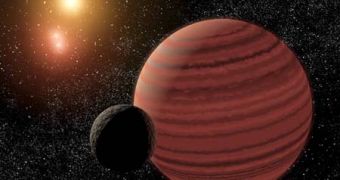Brown dwarfs, or failed stars, are stellar bodies with masses 10 to 70 times higher than Jupiter's. Although, like all stars, they have the capability of initiating thermonuclear fusion reactions in their cores, their masses do not permit them to sustain these reactions for a very long time, unlike typical stars, such as our Sun, which are able to burn hydrogen through nuclear fusion reactions for several billion years.
Canadian and French astronomers from Canada France Hawaii Telescope and Gemini North Telescope claim that they have found what appears to be the coldest brown dwarf ever, CFBDS J005910.83-011401.3, about 40 light years away from Earth. The object experiences a temperature of about 350 degrees Celsius and may have a mass ranging between 15 to 30 Jupiter masses, and is part of an isolated system, thus it does not orbit another object.
Brown dwarfs are believed to be the link between average stars and gas giants. In fact, calculations show that if Jupiter had been about 10 times more massive, it would have also initiated a thermonuclear fusion reaction, and now we would have been part of a binary stellar system. Stars are able to maintain the temperature in their cores at a constant level, however brown dwarfs become colder and colder as time passes.
Usually brown dwarfs are believed to be closer to gas giants than to stars, but even so, major differences between brown dwarfs and massive planets exist. Brown dwarfs have been proven to have large amounts of methane and clouds of dust and aerosols, similar to the atmospheric composition of the two largest gas giants in our solar system. However, water in the atmosphere of brown dwarfs is never found in liquid or solid state, while on gas giants it may condense into water ice. Ammonia, one of the other common substances in the atmosphere of Jupiter and Saturn, has never been detected in the near-infrared spectrographic analysis of brown dwarfs, until now.
The newly discovered brown dwarf seems to be extremely similar to a gas giant planet, due to its mass and low temperature, which suggests that there may be ammonia present in its atmosphere.
There are two types of brown dwarf stars, according to the temperatures they experience in their atmosphere. The first type, L dwarfs, have temperatures ranging from 1200 to 2000 degrees Celsius and an atmospheric composition mostly dominated by clouds of dust and aerosols. T dwarfs, on the other hand, have temperatures below 1200 degrees Celsius and an atmosphere composed of methane.
Nevertheless, the discovery of CFBDS0059 showed that a new type of brown dwarf, Y dwarfs, might exist. Because they contain large quantities of ammonia, they are much colder that L and T dwarfs, thus providing with a link between stars and gas giants experiencing temperatures lower than -100 degrees Celsius.
Additionally, brown dwarfs may prove invaluable to the study of exo-planets similar to our gas giants. Because this particular brown dwarf is an isolated object, it can be much more easily studied, opposing to planets around regular stars, which are extremely hard to observe due to the bright light emitted by the parent star.

 14 DAY TRIAL //
14 DAY TRIAL //